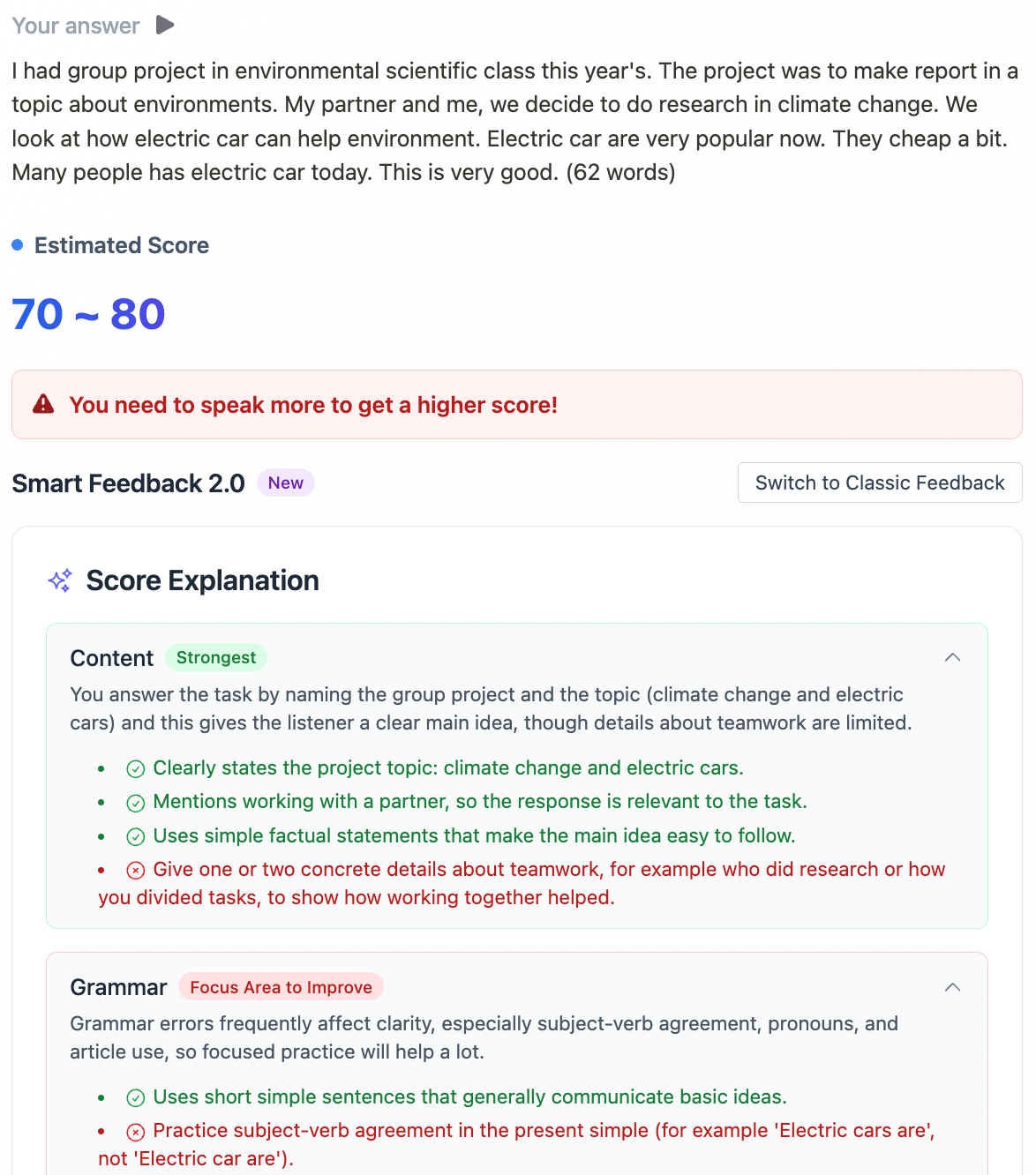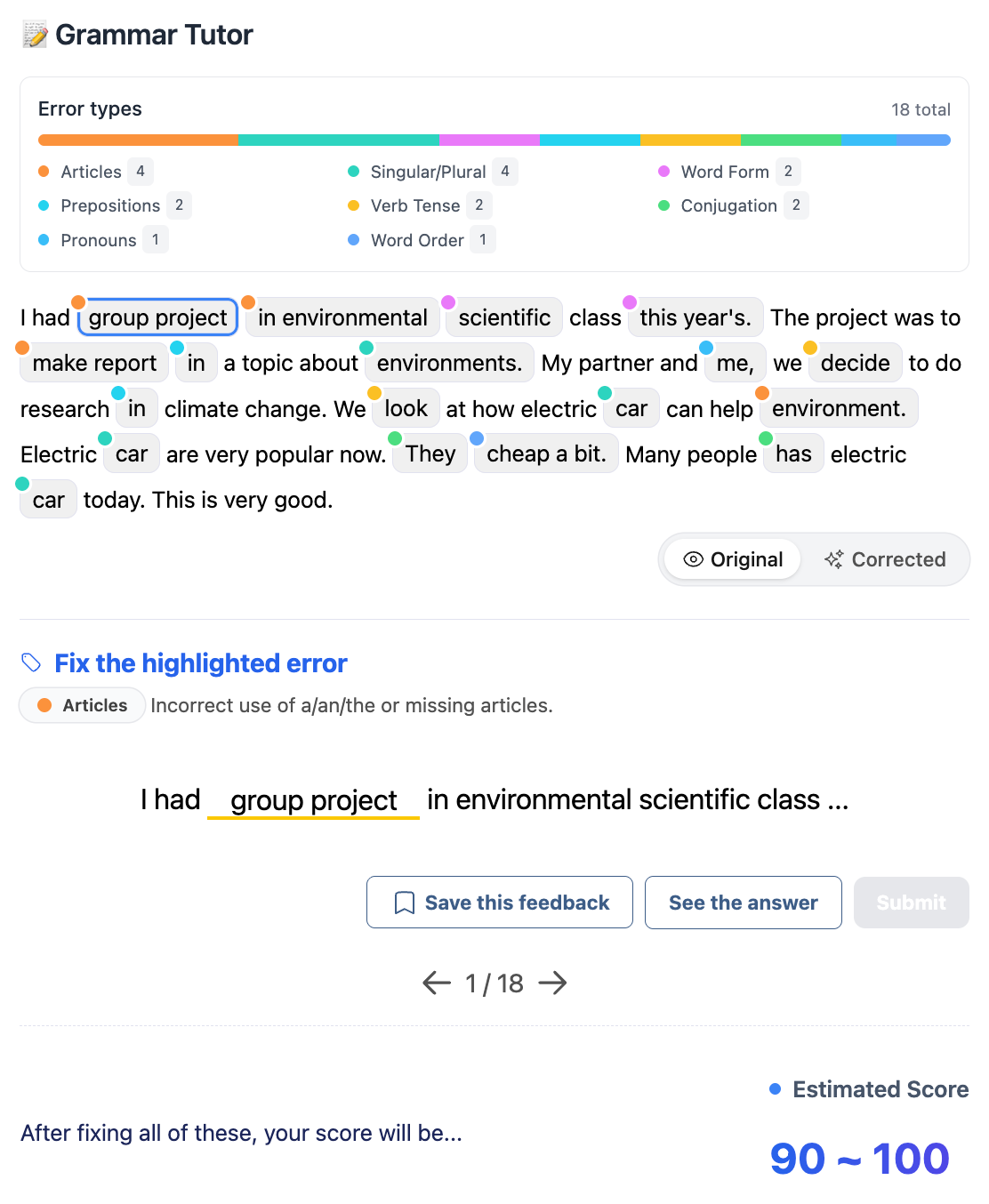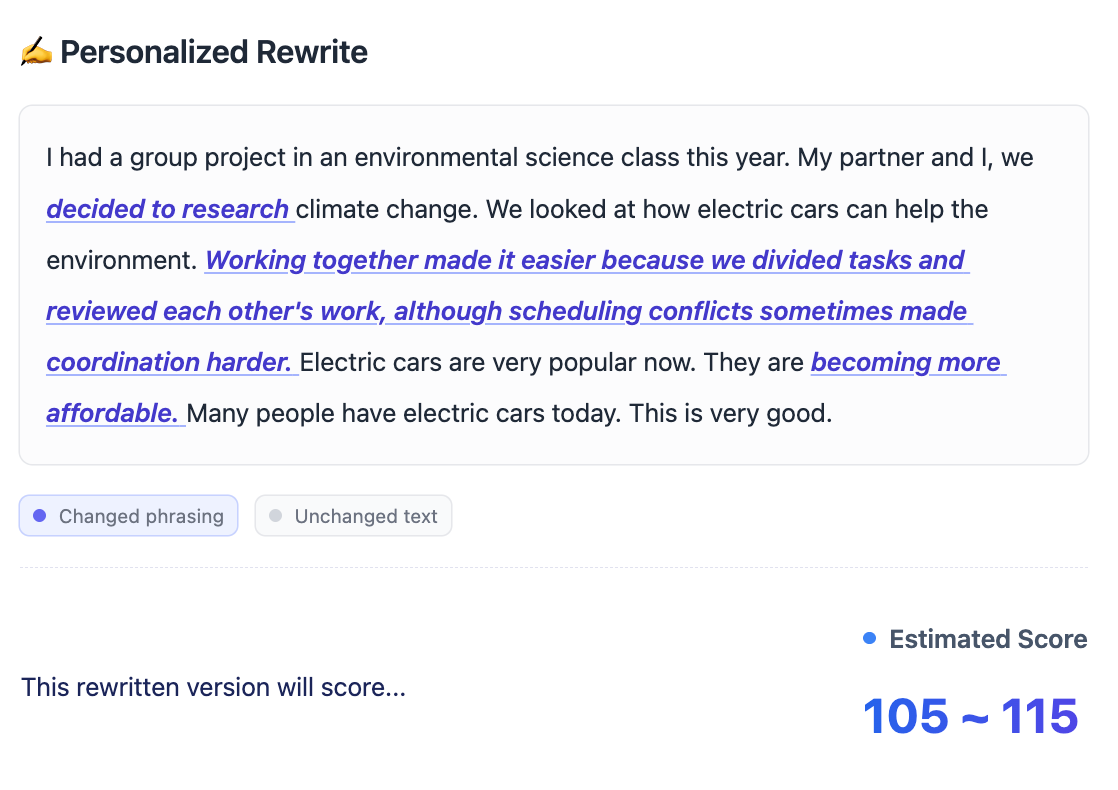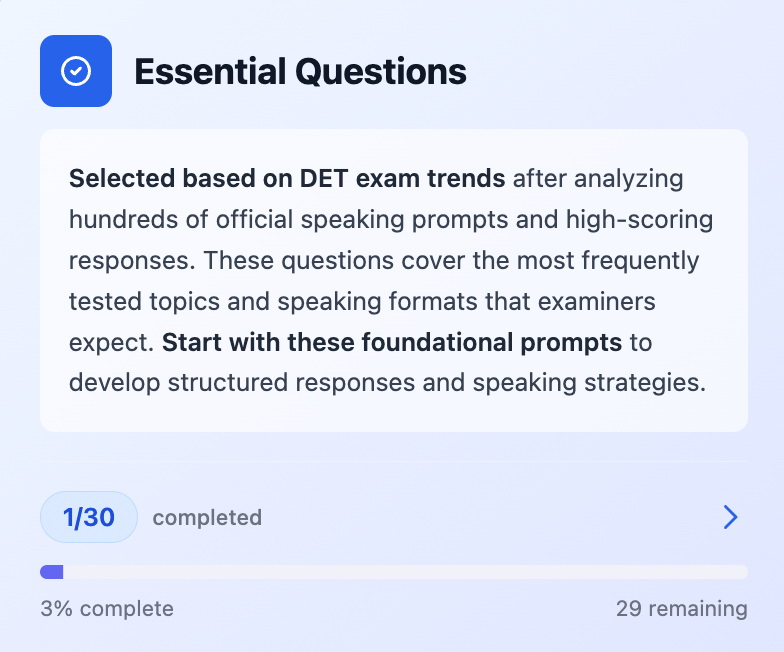Ultimate Guide to Speaking Questions - Duolingo English Test
In this article, we're going to cover everything you need to get high scores on all four DET speaking questions.

Table of Contents
- The Speaking Question Types on the DET
- How Duolingo Grades Speaking Questions
- Tips to Do Well on DET Speaking Questions
- Conclusion

The Speaking Question Types on the DET
There are 4 speaking question types on the Duolingo English Test (DET), and each one appears just once on the test.
- Speak About the Photo: You are given 20 seconds to study an image, followed by 90 seconds to describe it in detail.
- Read, Then Speak: You have 20 seconds to read a prompt, which usually provides a topic and three to four guiding questions. You then have 90 seconds to speak about the topic.
- Interactive Speaking: You will be given a series of 6-8 short questions and 35 seconds to respond to each one. You are not given any time to prepare your answers.
- Speaking Sample: This is the longest speaking task. You have 30 seconds to read the prompt and prepare your answer, followed by 3 minutes to respond. For this question type, Duolingo records you using both your camera and microphone, and this recording is sent to the institutions that receive your DET scores.
How Duolingo Grades Speaking Questions
Duolingo uses 6 scoring criteria for speaking questions:
- Content
- Task achievement / Relevance: How well does the test taker answer the question?
- Appropriacy of style: Does the test taker use an appropriate level of formality for the question? Do they use more first-person language when speaking about themselves?
- Development: How well does the test taker present and develop their ideas?
- Effect on the reader or listener: How clearly does the test taker communicate their ideas?
- Discourse coherence
- Clarity: How easy is it to understand the test taker’s ideas and position?
- Cohesion: How well are parts of the answer connected?
- Progression of ideas: Does the order of ideas in the answer make sense?
- Grammar
- Grammatical complexity: Does the test taker use a range of grammatical structures to express their ideas?
- Grammatical accuracy: How accurately are grammatical structures used? Do grammatical mistakes make the answer difficult to understand?
- Lexis (Vocabulary)
- Lexical diversity: Does the test taker use a range of words and phrases to express themselves? Are they able to avoid repetition?
- Lexical sophistication: How well does the test taker use less common words and phrases to express their ideas more precisely?
- Word choice: Do the words that the test taker used make sense? Are they natural and appropriate for the question? Do errors in word choice stop the test taker from being understood?
- Word formation: Are the forms of the words used correct?
- Fluency
- Speed: How easy to understand is the test taker’s rate of speech? Is the rate of speech comfortable to listen to? (Note: There is no ideal speech speed).
- Chunking: How naturally does the test taker pause? Does the test taker pause at the end of grammatical units (like clauses or phrases)? Do they use pauses for emphasis? Or do they pause unnaturally when trying to remember how to say something?
- Breakdowns and repairs: How much does the test taker rely on filler words and repetition? How often do they start and stop? Some use of these strategies is natural. Using these too much can impact fluency.
- Pronunciation
- Intelligibility: How easy or difficult is it to understand the test taker’s message?
- Individual sounds: How accurately does the test taker produce the sounds of English? (Note: All varieties of standard English pronunciation are acceptable. However, test takers must use pronunciation which is easy to understand.)
- Word stress: How accurately does the test taker use word stress?
- Sentence stress: How accurately does the test taker use stress? Are they able to use connected speech to maintain a natural rhythm?
- Intonation: How much and how accurately does the test taker use intonation to convey meaning?
👉 For explanations and examples to help you understand these scoring criteria better, check out this lesson on our YouTube channel:
The scoring criteria are very detailed, so let me provide a summary. Here are the four things you should focus on in your speaking responses:
- Answer the question: You must answer the question you are given, and to get maximum points, you need to answer all parts of the question.
- Avoid grammar mistakes: Focus on avoiding simple grammar mistakes, like incorrectly conjugated verbs or incorrect articles. These kinds of mistakes lose you the most points because they are basic grammar concepts.
- Express your ideas clearly and logically: In English, we value clarity above everything else. Use the right words to express your ideas. Make sure you move from one idea to the next in a logical flow and that you don't repeat yourself.
- Pronounce words clearly: Duolingo says explicitly that you don't need to have a specific accent. They just care that it is easy to understand the words that you are saying. Usually, the issue for students is that they are speaking too fast, and not giving themselves enough time to pronounce words well.
Tips to Do Well on DET Speaking Questions
Here are the most useful tips to do well on speaking questions, arranged into 3 categories: Before the Test, During the Test, and Pronunciation. You can read more about each one below.
Before the Test
- Learn strategies for each speaking question type
- Improve at picture description
- Make sure your test environment is quiet
- Use a good microphone
- Practice, practice, practice
During the Test
- Speak for the entire time
- Keep your eyes on the screen
- Speak loudly and clearly
- Slow down
- Speak from the belly
- If you make a mistake, don't panic
- Don't be afraid to pause
- Work on your pronunciation weaknesses
Pronunciation Tips
- Practice speaking with a pencil between your teeth
- Learn words with a silent 'b'
- Learn words with a silent 't'
- Master the schwa e (ə)
- Learn how to pronounce 'th'
- Master the difference between 'b' and 'p'
- Don't add a syllable to words that end in -ed
- Master how to pronounce words that end with -lly
- Learn how to pronounce 'h'
- Master the difference between 'v' and 'f'
- End your sentences with confidence
Before the Test
Learn strategies for each speaking question type: As you prepare, you want to make sure that you can produce a strong response for each question type and for each kind of prompt that you could see on the test. This will take some time, so it's important to start doing this early. The lesson below is a great place start. In it, I teach you the 3 kinds of writing and speaking prompts you could see on the test: Recount, Describe, and Argue:
From there, you can also learn useful vocabulary (like connecting words) and templates for different speaking prompts. We have a playlist on our YouTube channel with the most useful lessons to learn these things, which you can find here.
Improve at picture description: For most students, improving at picture description is the fastest way that they can improve their DET score. This is because we don't get much practice describing images in detail in daily life. Even a fluent English speaker will struggle to describe an image for 90 seconds. By learning some strategies, tricks, and vocabulary, you can quickly improve at picture description. What you learn will work for both Speak About the Photo and Write About the Photo.
Make sure your test environment is quiet: Take the test in a quiet, ideally silent, room to minimize background noise like fans, air conditioners, or street noise. Any sounds that aren't your voice will make it harder to hear you, which can hurt your score.
Use a good microphone: If your laptop or computer has a bad microphone, it will also be harder to understand your words, which can lose you points. You can borrow a laptop from a friend or even invest in an external microphone. However, you cannot use headphones on the DET, so the external microphone can't be attached to headphones or earbuds.
Practice, practice, practice: If you want to improve your speaking, you have to practice. There is no way to avoid that. You can practice English with friends. For example, agree to meet up for a coffee and only speak English. You may be able to find speaking partners in online communities. You can also practice DET speaking questions in Arno. On our paid plans, you get an instant estimated score and detailed feedback showing you exactly where you can improve. To create your free Arno account and test out the premium features for free, just click here.



Our team of DET experts at Arno analyzed thousands of DET questions, and we assembled lists of essential questions for each question type. If you can respond well to the 30 essential questions for the 4 speaking questions, you can be confident that you are well-prepared for the test.

During the Test
Speak for the entire time: You do not gain points by going faster on the DET. By using all of the time you have available, you will ensure that you have the fullest response possible, which will gain you points. At first, it can be difficult to speak for the entire length of the question, but that's why it's important to practice this as you are preparing. That way, when you take the test, you will have developed the right habits. Don't worry about how many words you should speak. If you speak for the entire time at a natural pace (so no really long pauses), your responses will be plenty long enough.
Keep your eyes on the screen: If you look away too much, Duolingo won't certify your results and you'll have to take another test. Staying focused on the screen can be challenging because we naturally look away as we speak in order to think. You need to practice staying focused on the screen as you are preparing for the test. We built a tool that tells you when you look away from the screen. You can also record yourself and watch the recording. Most people don't realize how often they look away!
Speak loudly and clearly: During speaking questions, you should pretend like you are speaking to someone across the room. By speaking more loudly, it will be easier to hear your voice, and it will help you to pronounce words more clearly.
Slow down: Most students speak too quickly on the DET. When we are nervous, like when we are taking a test, we tend to speak more quickly. You have to force yourself to slow down. It's also important to practice this as you prepare for the test. By slowing down, you give yourself more time to think and more time to pronounce your words carefully.
Speak from the belly: Another effect of nerves is that our bodies become tense and we speak from our throats. Our speech is much clearer when we speak from our bellies, and it helps us to relax which means that we think more clearly as well. An easy way to feel the difference is to put your hand over your belly button and then speak. Does your hand move as you speak? This means that you are breathing deeply and speaking from your belly.
If you make a mistake, don't panic: Even fluent English speakers make mistakes when we speak. If you realize that you made a mistake, you can correct yourself if you are still in the same sentence. But if you've already started a new sentence, just keep going. Even if you don't correct yourself, don't stress out. You can make mistakes and still get a really high score on the DET. I've gotten 160 on the DET twice – and perfect scores on mock tests many times – and I've made many mistakes in speaking and writing.
Don't be afraid to pause: It is much better to pause for a few seconds when thinking instead of filling every moment of silence with filler words (like "um" or "uh"). Many students don't realize how many filler words they are using, so you should record yourself answering some practice questions and then listen to your response. You should avoid pausing in the middle of sentences and instead pause at the ends of sentences and paragraphs.
Work on your pronunciation weaknesses: You should listen to your responses and identify words or sounds that are difficult for you to pronounce. You should either practice these words/sounds or learn synonyms to avoid using those problematic words during the test. Next, we're going to cover tips for the most common pronunciation issues people have in English.
Pronunciation Tips
For each of the tips in this section, we also created a short video that you can watch by clicking on the underlined portion.
Practice speaking with a pencil between your teeth: By putting a pencil between your teeth, you are forced to move your mouth more, which improves your enunciation. It may sound weird, but try it and you'll see how effective it is!
Learn words with a silent 'b': The most common words with a silent b are: subtle, bomb, dumb, thumb, climb, debt, and doubt. When saying these words, you can pretend the b isn't even there.
Learn words with a silent 't': There are also a lot of words with a silent t, and they are: listen, castle, ballet, soften, Christmas, and whistle.
Master the schwa e (ə): This is the most common sound in English. It appears most commonly when you have an unstressed vowel in a word, and it sounds like "uh". For example, in the word "about", that first sound is the 'schw e'.
Learn how to pronounce 'th': The 'th' sound (for example, in three) doesn't exist in every language so many English learners struggle with it. However, it's actually quite easy to say because it's so close to the pronuniciation of 's'. When you pronounce 's', you put your teeth together, push your tongue against the back of your teeth, and then push air out of your mouth. To make the 'th' sound, all you need to do is bite your tongue and then make the 's' sound.
Master the difference between 'b' and 'p': These two sounds are similar, but there is a noticeable difference. The 'b' sound comes from the back of your throat, whereas the 'p' sound comes from the front of your mouth. You can understand the difference by holding your hand in front of your mouth. When you pronounce 'b', you should feel your throat vibrate and just a little bit of air hit your hand. When you pronounce 'p', your throat shouldn't vibrate, and you should feel a lot more air hit your hand.
Don't add a syllable to words that end in -ed: When you pronounce a word like advanced, you don't want to pronounce it like this: advance + ed because this adds an extra syllable. Instead, you want to pronounce it like this: advanc'd. Don't let the e before the d confuse you. Most students find it helpful to ignore the e and just focus on pronouncing the d.
Master how to pronounce words that end with -lly: It's a similar thing with words that end in -lly, for example musically. You don't want to pronounce it like music + a + lly. Instead, you skip the a and pronounce it like so: music'lly.
Learn how to pronounce 'h': This another sound that doesn't exist in every language. You form the h sound by pushing air from the back of your throat, like you do when you're trying to breath onto a window so that you can draw something.
Learn how to pronounce the difference between 'v' and 'f': These two sounds are very similar. We start by pulling our cheeks back and biting our lower lip. For the v sound, I bite my lower lip a bit harder, and I have more vibration in my throat. For the f sound, I bite my lower lip a little less and I push more air through my teeth. To check if you're pronouncing each correctly, place your hand on your throat. When you pronounce a word with v (like very or valuable), you should feel your throat vibrate, but you shouldn't feel that vibration with f words like fun or family.
End your sentences with confidence: Many students have the habit of running one sentence into another. This makes your speech seem rushed, and it makes it harder to follow what you are saying. Instead, at the end of each sentence, you should take a brief pause. This gives the listener time to absorb what you just said, and it makes you appear more confident.
Conclusion
You should now have a solid foundation for speaking questions. You can go deeper by visiting the links in this article, visiting our YouTube channel, or exploring the other free articles we have on our blog.
While it's important to study strategies, tricks, and vocabulary, you also need to practice. For that, you should head over to Arno and create your free account to get unlimited practice questions for every question type. Just click below to get started:
